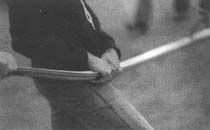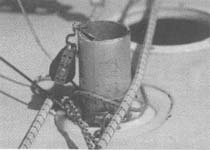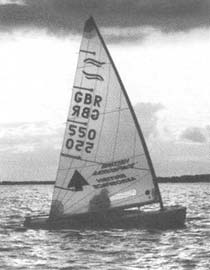Many masts?
Everyone needs something a little different from their masts. Many would buy as many as 6 to 10 masts to find the one with the bend that was best for them. There are stories of a sailor selling one of his rejects only to have the buyer come back and beat him with it. Many cut their tracks to change the bend characteristics. 1976 Olympics. For the 1976 Olympics in Kingston, Canada, the IYRU allowed participants to use their own rigs (but they had to use the hull furnished by Canada). At the Regatta, Mike Fletcher, the great Australian coach, told Australian Finn sailor John Bertrand that if he saw a hacksaw in John's hand one more time, he was going to take a hammer and break John's fingers. Allowing the competitors to bring their own rigs resulted in the closest boat speeds up to that point. |
The East Germans cut slots in their mast tracks with washers under the rivets' heads so the track could slide relative to the mast. This resulted in a mast that was soft in light air and stiff in heavy air. Later on, the Danes, Bjorn and Stig Westergaard had a variety of tiny shims that they taped into the track cuts to adjust their masts for the day's conditions.
Measuring bend
There have been at least a dozen different methods of measuring a mast's bend characteristics, each of which has advantages and disadvantages. |
 |
|
|
The Elvstrom, Bruder, Russian, Polish, Swedish and German methods all use carpenter's horses to support the mast either at the ends or at the black bends, hang a calibrated weight somewhere in the middle
and measure offsets sideways and fore and aft.
-
The Photographic method used large photos taken up the axis of the boom or perpendicular to it. The Henry Sprague or Guy Liljegren Shake Test is done by holding two masts to be compared by the tips at shoulder height
and shaking them vertically to see the fore and aft side modes of vibration. This requires calibrated eyeballs and is not very reliable.
-
The Strain Gauge Dynamic method places pairs of strain gauges at preselected points along the mast and measures deflections as a function of time.
-
The Horizontal Cantilever and Vertical Cantilever methods both pin the mast at the butt and deck ring and load the tip with either with a hanging weight or spring scale. John Bertrand used the Horizontal Cantilever with
the mast about four feet off the ground in order to get the fanned luff curve for a sail off the mast.
-
Another method is to hoist a sail with a standard luff curve and closely observe where the inversion appears when the sail is slowly
sheeted in. This is not a very reliable method.
Lamboley's mast
In 1977, IFA Technical Committee Chairman Gilbert Lamboley, France, built probably the most sophisticated aluminium mast. It was a single-tempered aluminium sheet wrapped around in an ellipse so that a flange along each side could be bolted to a track. The bolt tension could be changed so that the degree of upper twist could be controlled. It was a great mast, but Gilbert never went into production and today the mast is only seen on the Rhone river outside Lyon.
|
|
Miller Glass mast
In the same year the late Fred Miller from Newport Beach, California, tried to build a competitive glass mast. It was never accepted because they were a larger diameter at the top than the aluminium masts. Between 1980 and 1984 Gus Miller built a dozen S Glass masts about the same size as aluminium. They were fast in smooth water and especially off the wind. However, the dynamics of the material were not as good as aluminium in waves. Today they are still sailing but with new carbon coats.
|
Polish system
At the time of the 1992 Olympic Regatta, the ideal range of measurements for a successful mast under the Polish system were as follows: |
| Fore/aft deflection at 1/2 |
135-145 mm |
| Fore/aft Black Band |
31-32% of 1/2 F/A deflection |
| Fore/aft at 3/4 point |
89-91% of 1/2 F/A deflection |
| Side deflection at 1/2 |
175-180 mm |
| Side at Black Band |
28-30% of 1/2 side deflection |
| Side at 3/4 point |
90-91% of 1/2 side deflection |
|
 |
|
Carbon masts
In 1981 it was proposed to the IFA that carbon masts be allowed. Many were against the idea because they feared the development of an aerodynamically superior mast would be too expensive. By 1983, only England was against the idea. IFA decided to allow masts of any material for one year after the 1984 Games in Long Beach, California.
Peter Quigley of Larchmont, New York, made a couple of experimental carbon masts for the USOYC in 1985. Peter used one of them to come in second at the US National Championship. They were taken to the Finn Gold Cup in Palma de Mallorca for the IFA to see, but no one was willing to try them out.
In the late 1980s, Wisconsin's Bob Guidinger built a carbon mast over a plastic mandrel like an ice boat mast. He raced it in Miami until it broke at the deck.
The carbon mast idea languished for the next few years. The restrictions on minimum diameter were kept because of fears that an aerodynamically superior mast would make obsolete every aluminium mast in the world.
|
|
Opened up
At the 1990 IFA Annual Meeting in Greece the Technical Committee was instructed to open things up so that modern material could be used once the 1992 Olympics were over. The expectation was that while a carbon mast might be slightly more expensive, a sailor would only need two, because they would be so easy to modify. The class wanted experience with carbon masts and felt they were not taking advantage of an opportunity. It was also expected that with carbon, some of the advantages for small light sailors that were lost when the aluminium mast took over, could be regained. This is very important because many developing countries felt they did not have anyone big or strong enough to race a Finn competitively. Certainly in the US there are many good Laser sailors who are blown away by the Finn's power with an aluminium mast.
Experiments In
1991, Lawrence Lemieux of Canada and Needlespar both experimented with carbon tips for Needlespar 3M aluminium bottom tubes. After many months of working in Sweden with Swedish Olympic Finnster Fredrik Loof in 1993, the Swede Kurt Anderson produced a successful S Glass/Carbon mast with the same wet lay-up technique Gus Miller had used ten years earlier. Previous prototype masts had a number of breakage problems.
|
|
Success
This new-type mast had great success in the hands of great sailors during their first season and during the 1993 Europeans and Gold Cup. The mast was especially good off the wind but it did not outmode all the aluminium masts overnight. The success of these Anderson masts inspired Luca Devoti to start building masts in Italy and others in Europe to begin building their own carbon masts. The development continued throughout 1994 with more and more carbon masts becoming successful, although the cost and availability of some of them became a problem. At the time it was expected that market forces would eradicate these problems in the medium term.
Early carbon masts had to conform to the old weight rule, so many had to have correctors attached to them to bring them up to weight. This all changed for the 1995 Gold Cup in Melbourne when the minimum weight of the mast was reduced to 8 kg from 10.5 kg, although many masts still needed correctors. Almost everyone had carbon masts in Melbourne and the development of Finn masts had turned full circle with everyone sanding carbon off or adding carbon onto the mast to find the perfect bend, which was reminiscent of the old days of wooden mast shaping. Also in Melbourne, Hans Spitzauer introduced the first wing mast into Gold Cup scenery and won the Gold Cup in the process. |
(R)evolution -1999 It was great to return to the Finns and the 1999 Finn Gold Cup after nearly two and a half years away. The top sailors seem to keep getting more professional each year. Some things don't change though. New gear appears and Finnsters are buying everything in sight but haven't figured out how to use it. They call it having analysis paralysis.
Plastic sails have been making appearances since at least 1985. In most cases they were interesting experiments in the eternal search for Finn speed. As racing sails they were usually quite good in one condition, but steps backwards in all other conditions. When the wind dropped below their optimum condition they became too full and when the wind increased above their optimum, they became too flat.
The current revolution in Finn rigs started with Craig Monk having exclusive use of Team New Zealand sail material that they were using for gennakers. That was the first plastic to be suitable for a competitive Finn sail. The New Zealand effort for the Finn Olympics amounted to something like $500,000 NZD split between two competing camps. Last year the top Europeans went to NZ to train for the Sail Down Under series and had access to the Team New Zealand material which is lighter than dacron and stretchy enough for a Finn rig. Then the (r)evolution sped up and is still going on.
|
 |
|
Special material is now being manufactured just for Finn sails. One type of sail at the 1999 Gold Cup cost $2,600 because of material costs. Most are using wing masts that are too stiff for a 3.8 oz dacron sail but match the new material's stiffness. Wing masts can out point round masts probably because of their greater inherent twist which is being accentuated by making them relatively softer fore and aft in the top. The only condition where the old round mast rigs seem to have a chance is in light air and flat water. This points toward the dynamics of the stiffer wing mast being better in phase with the waves. When a puff hits now, the rig doesn't distort as much and more energy goes into driving the boat forward.
The new rigs are faster if you can keep them trimmed in a groove for the conditions but they are slower if you haven't put a lot of time in learning how to use them. They are not as good a combat sail for amateurs because they are not as forgiving as the old rigs. It is the case where the top group of highly funded professionals have fine tuned the use of a more sensitive rig. It is similar to high performance fighter planes which are inherently unstable and require a huge investment in training the pilot's skills. When they have the training, they are awesome.
Another element in the new rigs is the lighter, weight-jacket-less sailors. They are evolving new styles in steering and using the rig. This has been the history of the Finn. The biggest opportunity for increased speed has usually been the rig. |
|